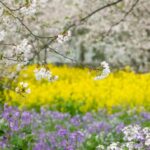Qiankou Ming and Qing Dynasty Residential Museum is located 27 kilometers north of Tunxi District in Huangshan City. The Hui-style ancient buildings from surrounding villages have been dismantled and reconstructed here, showcasing typical ancient residences, ancestral halls, memorial archways, pavilions, and bridges from the Ming and Qing dynasties. This allows visitors to understand various Hui-style architectures in a short time, hence the nickname ‘Qiankou Ming and Qing Dynasty Residential Museum’, which is truly fitting. Among the attractions around Huangshan City, Qiankou is surprisingly free of charge, making it an excellent value proposition. The small hill in the scenic area is lush with vegetation, offering a sea of green in spring and summer, and a touch of color in autumn, with a pleasant scenery.
Qiankou is divided into two areas: the Qing Garden in the south and the Ming Garden in the north. Start with the Qing Garden, where various Qing dynasty buildings are arranged along a circular tour path, including the ancient stage, Yi Ren Hall, Geng (Geng) Auditorium, Cheng Ren Hall, and Wang Shunchang’s residence, among which the official mansion Geng Auditorium is prominent in the Qing Garden. Although the buildings in the Qing Garden are imposing, they feature exquisite wood, brick, and stone carvings, with understated patterns painted under the eaves. However, they generally feel newer and lack an ancient charm, which has made them a popular filming location for many TV dramas and films. Passing through a lake from the Qing Garden, one arrives at the Ming Garden, which is the essence of the scenic area and requires climbing a small hill. Entering through the mountain gate, which was originally part of the Liu Shun Hall of the Wang family, and crossing the Yin Xiu Bridge, funded by a nun, one can see the beautifully carved Fang family ancestral hall stone archway. Interestingly, the archway lacks inscriptions but features a grimacing ghost, standing on a square bucket, forming the character ‘Kui’, indicating the founder’s wish for the family to produce more literary talents. Following the steps, after passing the Shan Hua Pavilion, funded by merchants, the first residential building, Le Shan Hall (Mao Die Hall), comes into view. This was originally a place for elderly people over 80 in the clan to entertain and discuss affairs. North of Le Shan Hall is the Wang family’s branch ancestral hall, Cao Men Hall. Continuing forward leads to the historically significant family ancestral hall, Si Jian Di. Then, in front of a group of houses on the north side, one can faintly see the construction method of the Yuan Dynasty in Wu Jianhua’s residence. The Fang Guantian residence, where ordinary farmers lived, is quite simple, while the carvings in Fang Wentai’s residence are exquisite. There is also the Su XueHEN residence available for visit. Standing on the hill where the Ming Garden is located and looking into the distance, one can see the ancient buildings’ horse-head walls blending with green trees, and in the distance, the modern villages and towns, with houses also built in the style of white walls and black tiles. If you are interested, after leaving Qiankou, traveling south for 1 kilometer along National Highway 205, you can see a Ming Dynasty Xia Jian Tower by the roadside, which is now overgrown with vegetation, exuding a sense of vicissitude. For dining or accommodation, Qian Kou Town has options available. The Hui-style village of Tang Mo, to the east, is about 4 kilometers from Qiankou, and the ‘Bagua Village’ of Cheng Kan, to the north, is about 8 kilometers away, both of which can be visited together.Qiankou Minju Museum’s opening hours are from 8:00 to 17:00 from May 1st to September 30th, with last admission at 16:30; from October 1st to April 30th of the following year, the museum is open from 8:00 to 16:30, with last admission at 16:00. The museum is closed on the 12th and 26th afternoons of each month, and details are subject to the public notice at the scenic spot.









